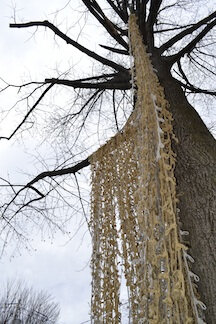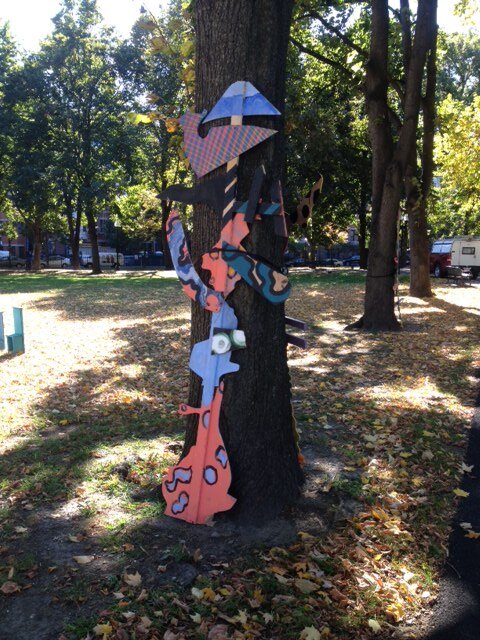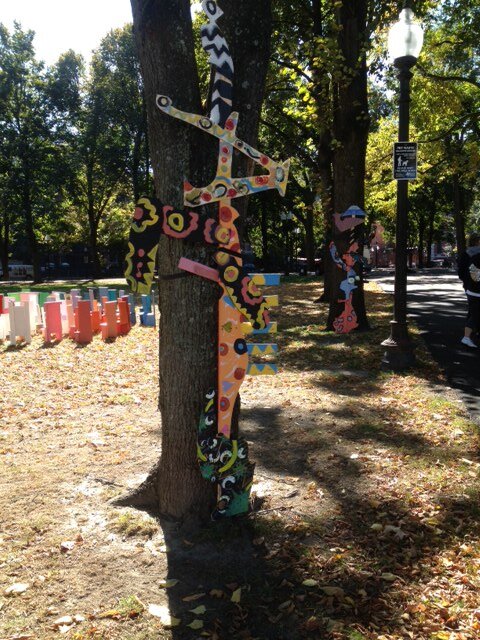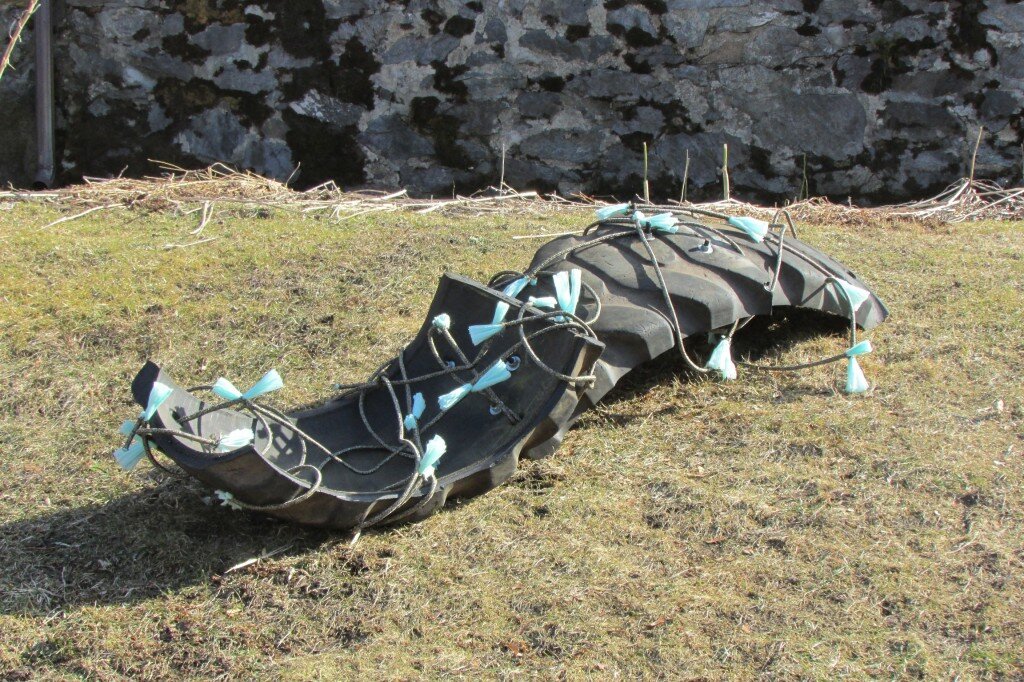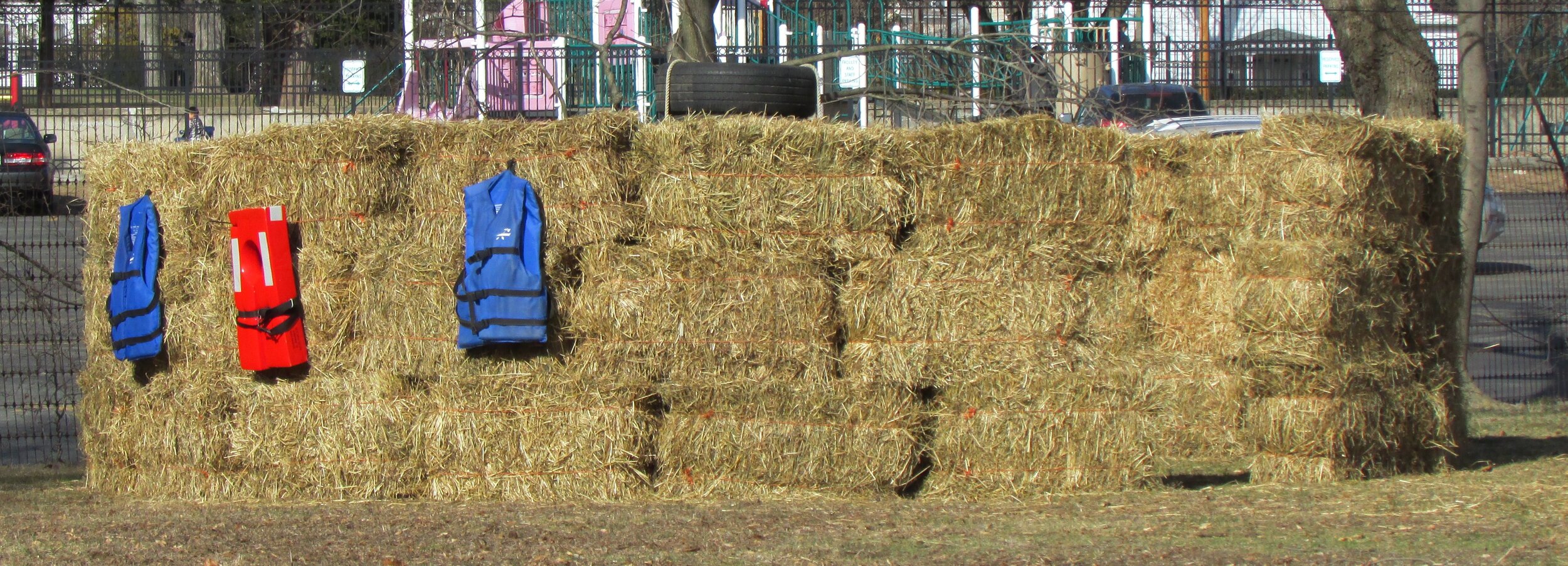Sponsors: Walsh Construction Co Inc., Joanne and Barry Reynolds, Craft Beer Cellar, Whole Foods
Poetry Walk & Chapbook
Turning Again to the Well:
Poems of the Energy Necklace Project,
Jackson Homestead, 2014
Chapbook and Poetry Walk Curated by Susan Edwards Richmond
Poets: Zachary Bos, Polly Brown, Cheryl Perrault, Linda Fialkoff ,Lynn Horsky, Neil Horsky, Terry House, Lila Linda Terry, Joanne DeSimone Reynolds, Susan Edwards Richmond, and bg Thurston
Poetry Chapbook pdf: Jackson Homestead chapbook
The Energy Necklace Project is the former name of Climate Creatives.
Exhibition
Gail Jerauld Bos
Children’s Chairs Project, 2013
Plywood, pine, paint
85 small children’s chairs, each chair: 3x1x1ft, surface area needed: 20x20ft
“These chairs represent the children in our community, The 8 red chairs represent the 8 children killed each day, day after day, in the USA by guns. The 48 white chairs represent the children seriously wounded each day, day after day, in the USA by guns. The other colors show all of the children affected by this violence. At present, they are being sheltered by this great tree, but when they look out towards their future… they see an extremely dangerous place… They need our attention and protection.”
Peter Kronberg
Reaching Hand, 2013
Cast Concrete, 3 roundels
each: 16” x 15” x 2 ½”
“Challenge: try to capture movement and human expression using hands, not faces. Birds move beautifully. Mushrooms because I was learning about them from Alex. Plants are evocative, and difficult to sculpt. I enjoy the opportunity to try to articulate myself in a material way. I use materials that have always been used to make sculpture: clay, wood, plaster, and metals but I also apply modern polymer mold making techniques.”
Peter Lipsitt & Susan Israel
Tempest Tossed, 2013
Steel, rubber, rope, wood mast. Reclaimed materials.
8′ l x 10′ h x 2′ w
“Tempest Tossed” recalls the trade voyages that first bound and transported slaves on these ships. Some slaves broke free and escaped through places like the Jackson Homestead as a stop on the Underground Railroad. But Tempest Tossed also evokes resilience and hope, lost and regained treasure, new beginnings, regeneration and reclamation.
John Powell
Solar Shards, 2013
“The piece is made up of multiple solar powered Plexiglas shards that will be hung in the mulberry tree at the corner of the lot — reflective in the daytime, light emitting at night. Reference is from a tale from Martin Buber about the Bal shem tov.”
Linda Hoffman and Gabrielle White
Procession, 2013
Metal, wood, and rope
“Procession explores the loss of connection to our agricultural past, to hard labor and handwork. Procession renews our commitment to connect with the land. The charred figures rise out of the soil to lead the procession with wisdom. The old wagon wheels drive this movement into a new future as we cultivate the earth, the source of our sustenance.”
Margot Stage
Umbilical, 2013
Clothing, beach rope
“Umbilical is a celebration of life and of the primal connection we have to each other and to the earth itself. It was created by braiding together strips of my recently deceased mother’s clothing, my clothing, and found beach ropes.”
Margot Stage and Linda Hoffman
Forest Falls, 2013
Twine, rope, string, fabric
20’x10’x.5’
Forest Falls references the power, fluidity, and endurance of water. Created by knotting various fibrous materials, this is the third in a series of collaborations between Margot Stage and Linda Hoffman.
Gail Jerauld Bos
Tree Dreams, 2012
Plywood, paint packing straps for tree attachment
6“ trees tied to trunks of trees: each tree 10fth x 1ftw x 2in thickness of wood
“Tree Dreams offers a visual interpretation of the joy that comes from being with trees. Fresh air, firewood, shade; what trees so generously give us does not entirely define this job. There is something wildly difficult to express…is it that these giants’ life on earth extends long after ours? This installation, made with cut and painted pieces of wood, is an imagined assortment of thoughts and dreams of trees.”
Milan Klic
Acquisitions of Light
“Light is becoming a precious property when human exploitation of earth escalates ‘climate change’, part of which is not only warming but ‘dimming’. This sculpture is a metaphor of anxiety from feeling the sky disappearing and earth enveloped in carpet of soot. We might begin collecting and ‘acquiring’ the light now for the future, even for trading on some market or other. It is my attempt to appeal to collective conscience.”
Susan Israel
Mobi, 2014
Reclaimed truck tires, metal fasteners, and rope
8′ l x 3′ w x 30″ h
The undulating forms of “Mobi” are entwined by a rope, like vines or seaweed, in a broken mobius strip. The rubber comes from a tire recycling plant that repurposes potentially toxic materials without chemicals, water, or waste. Here at the Jackson Homestead, this whale-like presence reminds us of the complex relationship between seafaring trade and slaves who first came on ships and later found their way to freedom here on the underground railroad.
Jeanne Williamson
Fence/Curtain 1.1
Mixed media on stiffened fabric
4′ high x 24′ long
Fence/Curtain 1.1 is a repurposed decorative barrier. It was originally created in 2011 as a 35′ long installation that gave the illusion of the curtain, valance, different layers of fabric, and the drape of the curtain on the construction site of the future performance hall for the ConstellationCenter which will be located in Kendall Square, Cambridge, MA.
It is made of monoprinted textures of different patterns of construction fencing, and handstamped and hand painted geometric shapes, on cotton fabric that is stiffened and water resistant.
Linda Hoffman
Ordinary Pine
Trunks of pinus trobus
Three carved trunks of pinus strobus – the stalwart of New England trees. Wander among us – look inside – reflect on our lives and stories.
Milan Klic
Drone
Aluminum alloy, resin, steel
9’ x 12’ x 4’
Drone is a metaphor of anxiety in a world saturated with surveillance and lethal technology, ultimately self-defeating.
Peter Kronberg
Jake, 2009
Terra Cotta
13” x 12 ½” x 12 ½“
Jake was at D-day on the beaches and saw action throughout WWII in France and Italy. He returned unscathed, but was not as fortunate when he returned to work as a cab driver in Boston. Having survived the terrible dangers of war, he was stabbed by a passenger in his taxi cab. Fortunately, Jake survived that too and lived to tell me his story and sit for his portrait.
Mary Dewart
Rescue, 2014
Hay Bales, Plants, Life Preservers, Life Safety Rings, Fossil Fuel Based Objects, Rope
12’ x12’ circle x 4’high
Rescue is an installation about humanity’s alarming dependence on carbon dioxide emitting, non renewable fossil fuels. Demands for fossil fuels are changing our climate and planet at an unprecedented rate. Will humans take action and make changes to reduce our use, adapt to renewable energy sources, and rescue life as we know it? Are we bystanders or life guards?
Artist Information
Gail Jerauld Bos
Gail Bos is an artist who has worked on many installations over the years. Usually, the installations with strong political focus are set up on street corners and at random sites throughout a city. Other installations are developed for shows held at the historic Footlight Club in Jamaica Plain, the Massachusetts Statehouse Doric Hall, and the Cambridge Art Association. Gail Bos, in conjunction with The Museum of the National Center for Afro-American Artists, does early education art programs in the Boston Public Schools. Her studio is located at 52 Green St. in Jamaica Plain.
Contact: gailbos@comcast.net Website: www.gailbos.com
Mary Dewart
Mary Dewart is a landscape designer and climate activist. She has taught numerous design workshops, including Creating Sacred Space in Your Garden and Your Life, and initiated and produced a wide-ranging series of events and displays for all ages entitled Brookline Climate Week, a community call to climate education and action.
Linda Hoffman
Linda Hoffman has been part of the New England artist community since the early 1980’s. Her work is in the collections of Harvard University, the Boston Public Library, the Pierpont Morgan Library, NY, Hechinger Tool Museum, DC, and the Acton Arboretum, as well as many private collections. This spring she will install Tree Harp, a large bronze sculpture commission for the Town of Littleton, New Hampshire. In the summer of 2001, she moved to Harvard, Massachusetts, and began work to bring back an abandoned orchard. In 2006, Old Frog Pond Farm became the first certified organic pick-your-own orchard in the state. Hoffman and her partner, Blase Provitola, host community, art, and agriculture events at the farm throughout the year, including the annual outdoor sculpture exhibit Around the Pond and through the Woods during apple picking season.
Susan Israel
In 2008, Susan decided that she wanted to do something to improve the environment that would have an impact beyond what she could do practicing architecture, as she had been for my entire career. What would motivate other people to do more as well? Something fun and visible. What was preventing people from doing more? Fear, and lack of belief that their actions matter. So she created the Energy Necklace Project to connect a community that fosters awareness and action about improving the health of our environment using art. She has collaborated with Peter Lipsett on several pieces for group exhibitions, including one at the New Bedford Museum of Art.
Milan Klic
Mine is a story of an immigrant, cultural fusion— ongoing, never complete. I was born and educated in former Czechoslovakia, today’s Czech Republic. At that time, the country was a part of the communist bloc and all aspects of culture, visual arts in particular, were subject to political dogma and tough censorship. My natural inclination towards sculpture seemed unrealistic in such an environment, and my desires had to be put aside, postponed, silenced, and reduced to dreams. I chose Natural Sciences (math, computer science) as a practical survivor’s way. I graduated in 1974 from Palacky University, Olomouc with an MS and began my career as computer programmer.
As happens with totalitarian regimes, oppression spawns an underground subculture where individuals live and create in seclusion, hiding from the society rather than seeking meaningful communication with others, except those who are in similar predicament – “internal emigrants”. But, dreams are weaving their fabric in their realm, spontaneously, beyond rational and practical considerations. As a way of spiritual survival, I was seeking expression in visual arts, first drawing and terra-cotta sculptures, then wood-carved, figurative ones. Most of the early figures are now in various private collections in Europe, others here in the US, reminders of a period of still evolving style. Several of my exhibitions in the old country were recognized and appreciated, mostly by people tied to the subculture by a similar inner gravity. The conditions in the former communist regime eventually led to my emigration in 1985.
Exposure to highly technological, concept-driven civilization manifested itself in my art with transformed perception, themes, materials used, and aesthetic values. After the “Velvet revolution” in Czechoslovakia, when we all sighed with some relief, my sculptural expression was of a rather intimate, lyrical nature. I gained a lot when I studied sculpture at Brandeis University in Waltham, MA from1989-1992. The relatively peaceful 1990’s produced an array of spatial metaphors in my art, still readable in the language of classical abstract modernism, bearing the seal of European heritage. But things are not going “velvet” in the contemporary world; recent years have profoundly changed our ways of thinking about the world and anxieties yet unknown are now common articles of everyday experience. I feel it as my inner choice to respond to this traumatized social and cultural milieu.
Peter Kronberg
I am a business attorney who also makes sculpture. I live and work in Newton. I studied sculpture in school, so I am not entirely self-taught. I have shown and sold my art over the years and I could provide you with a list of where and who but it isn’t terribly impressive and will bore you.
Peter Lipsitt
Peter Lipsitt has shown outdoor sculpture at Harbor Arts East Boston; Boston City Hall; Old Frog Pd., Harvard, MA (w/ Susan Israel); Chesterwood in Stockbridge, MA; Lars Andersen Park, Brookline, curated by Nick Capasso; Triangle Arts Association, founded by Anthony Caro in Pine Plains, NY; Lewis Wharf, Boston; Tiverton, RI; Wheaton College, Norton, MA; Wheelock College, Boston, MA; Sculpture Key West, Key West, FL; Rose Museum, Brandeis University, Waltham, MA; and Art Complex Museum, Duxbury, MA. His work is in the collections of the Rose Art Museum, Fogg Art Musuem at Harvard University, Fort Lauderdale Museum, DeCordova Museum, Hamilton College, Vassar College, and in many private collections. Recently he completed a commission for a large outdoor steel work in New York state.
He also has permanent large-scale public sculpture at Bajko Skating Rink in Hyde Park, MA, University Place, Cambridge, and has outdoor work on extended loan in the outdoor atrium at Boston City Hall.
Lipsitt, raised in an ocean-front Massachusetts village, is a graduate of Brandeis University (BA) and Yale University School of Art (BFA, MFA-1965). He also attended the Skowhegan School program. In the 1960s he taught in the US Peace Corps in Ethiopia. At various times he has been a professor at Brandeis, Wheaton College, Emmanuel College, and Wentworth Institute in sculpture, drawing, and/or design.
As a founding member of Boston Sculptors Gallery, he has presented many solo exhibitions in its successive gallery locations. Fuller Art Museum, Wheaton College, Brown University, and Mather House, Harvard University have each given him solo exhibitions.
Lipsitt works in a variety of cast and assembled materials, most recently cement, steel, and wood, as well as bronze and aluminum works in unique casts. He is the recipient of a generous grant in 2007 from Artist Resource Trust (A.R.T.), a fund of Berkshire Taconic Community Foundation, faculty grants from Wheaton College, and other grants from the Brookline Arts Council. His longtime studio is in the Piano Factory, South End, Boston, MA.
Margot Stage
Margot Stage was introduced to fabric art in 2001. Previously, she worked as a National Public Radio producer and host, primarily at WGBH, and as a freelance writer. Stage’s work in the visual arts was immediately accepted into juried exhibitions and has been shown extensively. Recently, she has expanded into three-dimensional work and installations.
Her work has been selected for exhibition at The Carnegie Center for Art & History, Indiana; The International Quilt Festival, Texas; Anderson Chase Gallery; and Main Street Gallery, New York. She has been accepted in the Northeast Prize Show and RED and BLUE at the Cambridge Art Association, and has shown her work at the Arsenal Center for the Arts, Fruitlands Museum, Fitchburg Art Museum, Arnold Arboretum, Whistler House Museum of Art, Brickbottom Gallery, Lesley University, Bunker Hill Community College, Indian Hill Music Center, Moose Hill Audubon Gallery, Concord Art Association, The Center for Art in Natick, Fiber Arts Center, Gallery 119, and Brush Art Gallery. Her audio art piece “Dune Shack Sound Track” was exhibited at The Schoolhouse Center for the Arts in Provincetown. Her monoprints were shown at the DeCordova Museum School Gallery.
Stage’s work has appeared in Fiber Arts Magazine, The Boston Globe, The Lowell Sun, Wild Apples, The Middlesex Beat, The Ithaca Journal, The Boston Phoenix, and The Westford Eagle. Her work is held in the collections of Enterprise Bank, The Jeanne D’Arc Credit Union, and by many private individuals. She works out of the Western Avenue Studios in Lowell.
Gabrielle White
Gabrielle White is a self-taught artist who has been sculpting and constructing art from repurposed material since childhood. She was inspired by her grandfather whose basement workshop held a magical array of bent and rusted objects waiting for a new life. Time spent in the woods, at rivers, and on mountains gave her a child’s eye and the heart of an explorer. Travels to Nepal opened her eyes to the spiritual realm and the connectedness of all things.
She is always experimenting with new ways to express a story through the creative recycling of items found in scrap metal piles, thrift shops, demolition sites, and old barns. Her sculpture uses bicycle wheels, cast iron gears, glass, old tools, wood, and stone to communicate our connection to the natural world. Through her pieces, she seeks to create the balance point between/within the physical and spiritual realms.
Jeanne Williamson
Jeanne Williamson’s work can be seen in galleries and museums, and in many books and magazines. A print of her work is also available at Crate & Barrel stores.
She has a BFA from Philadelphia College of Art (now the University of the Arts), where she majored in Fibers/Crafts. In addition to being trained as an artist, Jeanne has an MSAEd in Art Education from Massachusetts College of Art.
Jeanne is represented by the Gravers Lane Gallery in Philadelphia, PA, and the deCordova Museum of Art Corporate Art Loan Program in Lincoln, MA. Jeanne lives in Natick, MA with her husband.
website: http://www.jeannewilliamson.com









